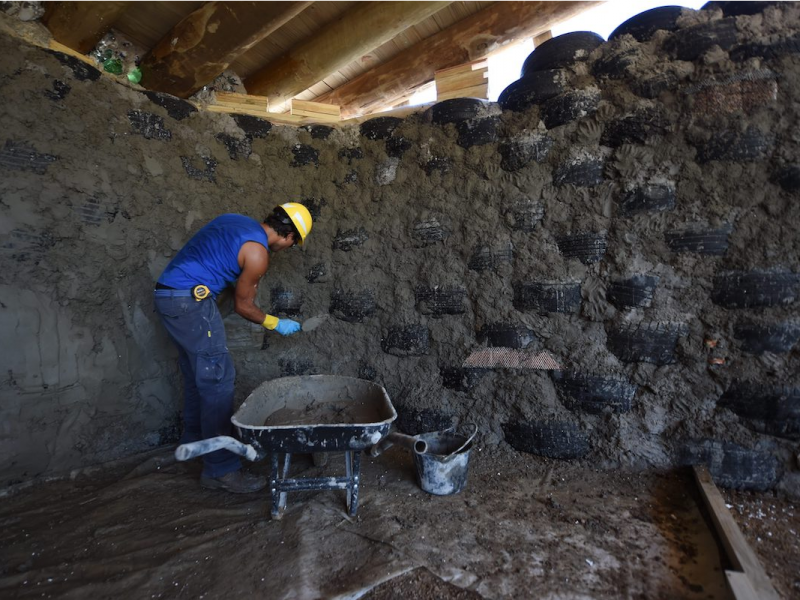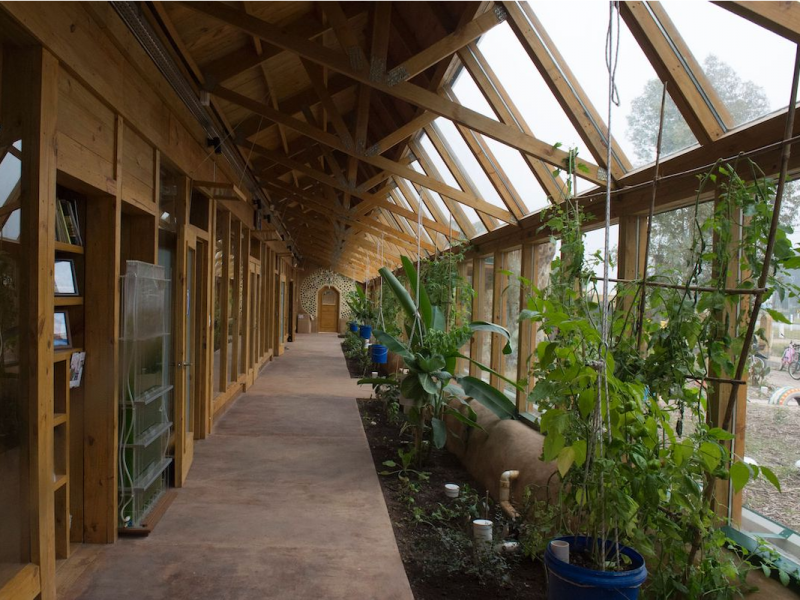- While a majority of the world’s daily lives have changed during the lockdowns, a small population has been living relatively unaffected by the coronavirus.
- People living in Earthships, which are off-grid, self-sustaining homes, haven’t had to make many adjustments in their daily lives.
- The homes, which are often in rural areas, provide owners with food, water, shelter, and electricity.
- As the coronavirus puts limits on people’s lifestyles, there has been an uptick in the interest of autonomous homes.
- Visit Insider’s homepage for more stories.
A day in lockdown for Craig Cook is no different than any other day.
The pandemic has him considering building a greenhouse, but besides that, Cook’s life hasn’t changed. He didn’t wait in long lines at the grocery store or transform T-shirts into face masks. If he’s hungry, he heads to his indoor garden where he’ll grab fresh produce, like a banana, fixings for a salad, or sweet potato.
“As far as the lockdown goes, our lifestyle hasn’t changed at all,” Cook told Insider.
He attributes that to the home he’s living in.
Cook and his wife, Connie, live in a sustainable home called an Earthship that's located on the outskirts of Ontario, Canada
Cook's home is completely autonomous. The retired couple used upcycled materials, like bottles and tires, to build a home that regulates heat, collects rainwater, processes sewage, and functions as a greenhouse to grow food. With the help of solar panels and wind turbines, the building's electricity needs are met.
"No matter what happens in the outside world, it doesn't affect us at all," Cook said.

There are about 3,000 Earthships sprinkled around the world. The biggest Earthship community is located in New Mexico, where the founder of the movement lives.
Michael Reynolds, an architect, built the first Earthship in the 1970s
"There was an observation that the way we live on this planet is not really that stable and that secure, not to mention that ecological," Reynolds told Insider. "I observed those things and started trying to build a building that addressed them."
Forests were being clear cut for timber and trash was exponentially increasing. To help solve those two problems, Reynolds built a house made of beer cans.
The idea spread, and Reynolds started using old tires and bottles to build structures.

Over the decades, he's identified what he believes are the six things all humans need to survive: food, energy, clean water, shelter, garbage management, and sewage treatment.
An Earthship meets all of those requirements.
A traditional Earthship is built into the ground, where the ground helps regulates temperatures. Windows on the south side of the building create warmth and sunlight helps grow food.
"When you come up against something like the coronavirus, you're sitting in a building that addresses your sustenance issues and you see this is the right direction for sure," Reynolds said.

Mark Fleischhaker said the lockdowns have also reassured him of his life choices
Fleischhaker lives in the Darfield Earthship outside of Kamloops, Canada. He moved in after the family that built the home moved out.
Fleischhaker has lived in the Earthship for just over two years.
"For me, it's kind of felt like business as usual because this is how I've always been living," Fleischhaker told Insider.
Fleischhaker regularly stocks up on food. The closest grocery store is a half-hour away and the nearest Costco is an hour drive.
During the lockdown, he said he hasn't needed to visit a major town yet. Nearby gas stations provide him with any necessities he needs, but even those he doesn't visit often. He still has dear and fish in his freezer from last season, and tomato sauce, canned peaches, canned pears, and chutney the owners left behind.
He's also started cultivating his outdoor garden for the season.
"Nobody around here seems too stressed about anything, and it seems like there's a lot of stress in the cities," he said.
Fleischhaker also attributes some of the resiliency to rural communities. During Canada's lockdowns, many of his neighbors have come together. They help with projects, trade seeds, and host dinners.

Interest in Earthships has grown during lockdowns
All three Earthshippers Insider spoke with saw an uptick of interest in their style of living.
For many, this is one of the longest periods of time people have spent inside their homes. How and where people live is constantly on people's minds.
Reynolds runs the Earthship Academy, which offers online classes for landowners interested in building their own Earthship.
His classes have more people than ever. Reynolds said he's seen the interest slowly grow over the last few decades, but this pandemic has caused interest to "crescendo."
"It really is reinforcing the last 50 years of work," he said. "It's making me see that you are going in the right direction. Now, just go as hard as you can for the rest of your life."

Cook's inbox has also been filled with interest.
"We have got a pile of emails from people saying this has opened their eyes," Cook said.
Cook believes that the financial appeal also drives a lot of people to consider building Earthships
He estimates that his 3,000-square-foot home cost him $70,000 to build (the couple built the home, so labor isn't factored into the cost).
And now, his only monthly cost is property taxes. There's no electricity, water, or gas bill. There's no mortgage payment or concern if gas or hydro is raising in costs.
"Those monthly costs are what people are drowning under," Cook said.
Beyond the concern for the planet, there's a financial incentive.
"We consider ourselves to be incredibly lucky to be living here and have what we have," Cook said. "But a lot of work went into being lucky."
Fleischhaker, a structural engineer, has seen a growing interest in sustainable designs among his friends and clients.
"A number of my clients are talking about focusing more on agriculture now, which is cool," he said. "I think it's triggered kind of increasing interest, whether it's off-grid or rural living."
Meanwhile, his friends have been checking in to see if they can visit.
"It's kind of tough to be bored over here, but I think people are getting bored in the city and looking for projects to do," he said.
While a person living in a New York apartment or a suburban home in Texas might not be able to build an Earthship, there are broad takeaways that everyone can consider
The largest one is being more self-sufficient.
While a lockdown had many people considering isolation for the first time, Fleischhaker has always focused on how he's living independently.
"I think my life choices have been set up to increase my resilience," he said. For the last four years, Fleischhaker has been transforming an Airstream trailer into an off-grid home.

Adding a small vegetable garden to a balcony or backyard can be a good place to start. Other skills, like learning to pickle vegetables or keeping a stocked pantry, are simple but helpful skills to build.
For bigger projects, homeowners can build rainwater collectors or add solar panels and become less reliant.
Reynold's team also works on retrofitting homes to be more self-sustaining. Projects, like building domes over houses or adding greenhouses to a building, help reduce a home's dependence on the grid.
Reynolds acknowledges that it's not feasible to replace every building with an Earthship
But he hopes that homes and buildings can be retrofitted and that the government can adjust its building codes to allow for new models of living.
Reynolds attributes these challenges to a misplaced value on tradition and culture.
"Tradition and culture make a beautiful coffee table book, but stop right there," Reynolds said. "Because tradition and culture are actually inhibiting the evolution of different ways to live on this planet."
Reynolds hopes that people prioritize how they live and its impacts on the environment.
"Make the machine take care of you first and then worry about tradition, culture, and aesthetics," he said.
- Read more:
- A restaurant in Amsterdam built small greenhouses for diners to enjoy a meal in while social distancing
- What life is like for a family quarantining in an empty treehouse village that usually accommodates 52 people
- An artist turned a closed diner into an art gallery during lockdown by hanging her colorful paintings in the windows
- A couple living on a sailboat had plans to cross the Indian Ocean before lockdowns put their journey on hold in Malaysia
